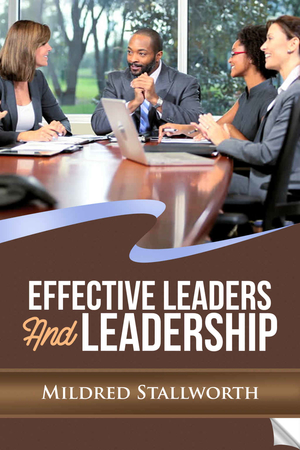
In this straightforward and surefooted guide to becoming an effective leader, author Mildred Stallworth offers a compendium of ideas that can prove helpful to people in all aspects of professional and personal life in Effective Leaders and Leadership.
Leaders, Stallworth says, create a vision that others can then follow. Comparing the leader of an organization to the head of the human body, she suggests that the “head” of a group has the responsibility to think and make decisions to control the actions and directions of the group as a whole. The head literally oversees the body; if the head – brain, senses, thoughts and feelings – is dysfunctional, the body or organization will be, as well.
Basic leadership skills listed by the author are integrity, prioritization, communication, etiquette, listening, consistency, decisiveness, accountability, compassion and transparency. It takes a certain kind of person to lead: many may be willing and ready, but are they able? Leading requires innovation, authority, and boldness; leaders must be willing to follow their own dictates, to set an example to others; they must respect, attract and include their followers as they go forward together.
Leaders have to be truthful, to practice what they expect others to fulfill without trickery. They have to be organized and have the skills to communicate organizational necessities to others. Etiquette requires “behavior which separates intelligence from stupidity.” The willingness to listen to those under your supervision promotes trust. In making decisions, the group must feel that their leader has done the research, knows the product, has explored the techniques, and will be accountable for the success or failure of his or her decisions. In sum, the book offers a wide-ranging and prescriptive look at all facets of leadership.
Author Stallworth is a successful business owner who manages an online, product-based marketplace. In creating this guide, she has gathered quotations many spheres of life. Those quoted include South African revolutionary leader Oliver Tambo, businesswoman and politician Carly Fiorino, leadership expert Warren Bennis, and General Norman Schwarzkopf. Her choices sometimes lean to the conservative, so that will be the larger market for her work.
In the mid-portion of this neatly organized guide, which is peppered with vivid color photos, Stallworth leads the reader outward from the realm of specific organizational or industrial leadership to more general environments and directions, such as leadership coaching. She examines in some detail the ins and outs of assuming a role as a political leader, who will, she asserts, “focus on his or her constituents, always willing to listen at any time.”
From that point on, she shifts her perspective from secular notions of leadership to a purely religious, Christian viewpoint that she clearly espouses, beginning with the necessity for spiritual leadership in the home and community. She cites the guidance of Jesus, the good shepherd, as the best possible example of unfailingly reliable leadership from which we can take strength to lead others in any arena of life. This latter portion, while undoubtedly heartfelt, places the book in a slightly different, though no less worthy category, which is not entirely in keeping with the rest of the book, or the cover, so it may come as a surprise to some readers.
Nonetheless, this particular concentration might provide a welcoming readership, making it a practical instrument for Christian business people and even Bible study groups seeking new avenues of exploration.
Book Links
STAR RATING
Design
Content
Editing
Get an Editorial Review | Get Amazon Sales & Reviews | Get Edited | Get Beta Readers | Enter the SPR Book Awards | Other Marketing Services























Leave A Comment